Often called cerused oak or limed oak, cerused wood is an elegant finishing technique that showcases the grain patterns of wood. This step-by-step tutorial will guide you through creating the effect yourself on any species of wood.

If you are looking to add an elegant finish with old-world charm, Cerusing is the perfect technique. Originally developed in the 1500s, it is currently enjoying a renaissance among furniture refinishers and DIYers.
It’s called Cerusing Finish (or sometimes Limed Finish), and it’s a process of rubbing a contrasting color into the pores of wood to highlight the patterns of the wood grain, similar to a whitewashing technique.
With its impressive style and antique look, the unique pattern options are endless. If you are looking for something elegant and unique, give this technique a try!
Cerusing vs Liming Wax
There are two techniques that produce similar effect, although they work completely differently.
The first, and easiest, is using a liming wax, which is basically just a white furniture wax. This is the liming wax brand I most use. You use it a lot like a furniture wax, where you apply a paint and then buff the furniture wax into the grain pattern.
For a low or medium traffic piece such as a side table or dresser, I prefer liming wax finish. The process is slightly easier, and you have a bit more control with layering the wax. However, a wax will never be as durable as polyurethane, and you will have to rewax it eventually.
The second method is layering paint to bring out the grain pattern. For a high traffic piece such as this dining room table, I prefer this method because high traffic furniture needs a durable topcoat to fully protect it, and you can’t use wax under a polyurethane coat. This is the method that I detail below.
Best Wood Types for Cerusing
Cerused oak is the most common species because it already has a strong grain pattern that shows easily. In fact, red oak doesn’t require any wire brushing or prep to get the look. White oak is also great, but the pores are smoother with a more subtle grain pattern.
This technique, however, works very well with many species including mahogany or cherry. In fact, I prefer it on species like this maple table because they have a more delicate grain pattern. However, I don’t recommend this technique on pine or burled wood.
Look at the graining pattern on a surface and you can get an estimate of how the cerusing will look once finished.
Supplies
These are the items that I use most often with this technique. If your furniture needs to be stripped or prepped prior to starting the cerusing, here is our tutorial for stripping wood furniture.
- Wire Brush
- Sand paper – I use 120 grit for smoothing and prep, 220 or 300 grit for removing paint or final coats.
- Random Orbital sander
- Drop cloths
- Steel wool
- Lint free towels
- Stain or Paint of your preference for bottom layer
- Paint
- Paint Brushes
- Clear Topcoat of your preference
How to Ceruse Wood
This technique utilizes paint to create the cerusing technique. It is different from using liming wax because the table can be sealed with a clear coat that is hard and durable.
Step 1: Prep the wood surface
For best results, all previous stains, paints, and polyurethanes must be removed. Even if you like the finish underneath, you will be accentuating the pores with a wire brush, so that alone will ruin any current finish. If your table needs to be stripped, I have an excellent tutorial on stripping wood furniture that will walk you through that process.
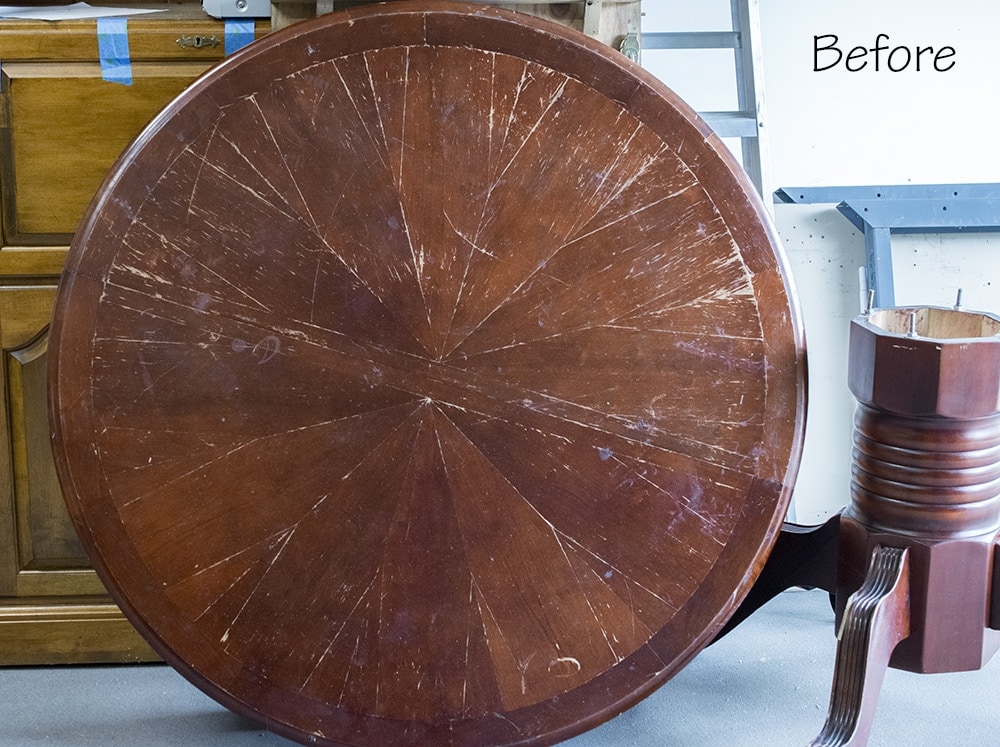
As you can see, this was how the table came to me. It has an interesting pattern when the center leaf isn’t incorporated, and I wanted to highlight that pattern even more. So let’s see how it turned out!
Step 2: Wire Brushing the Wood Grain
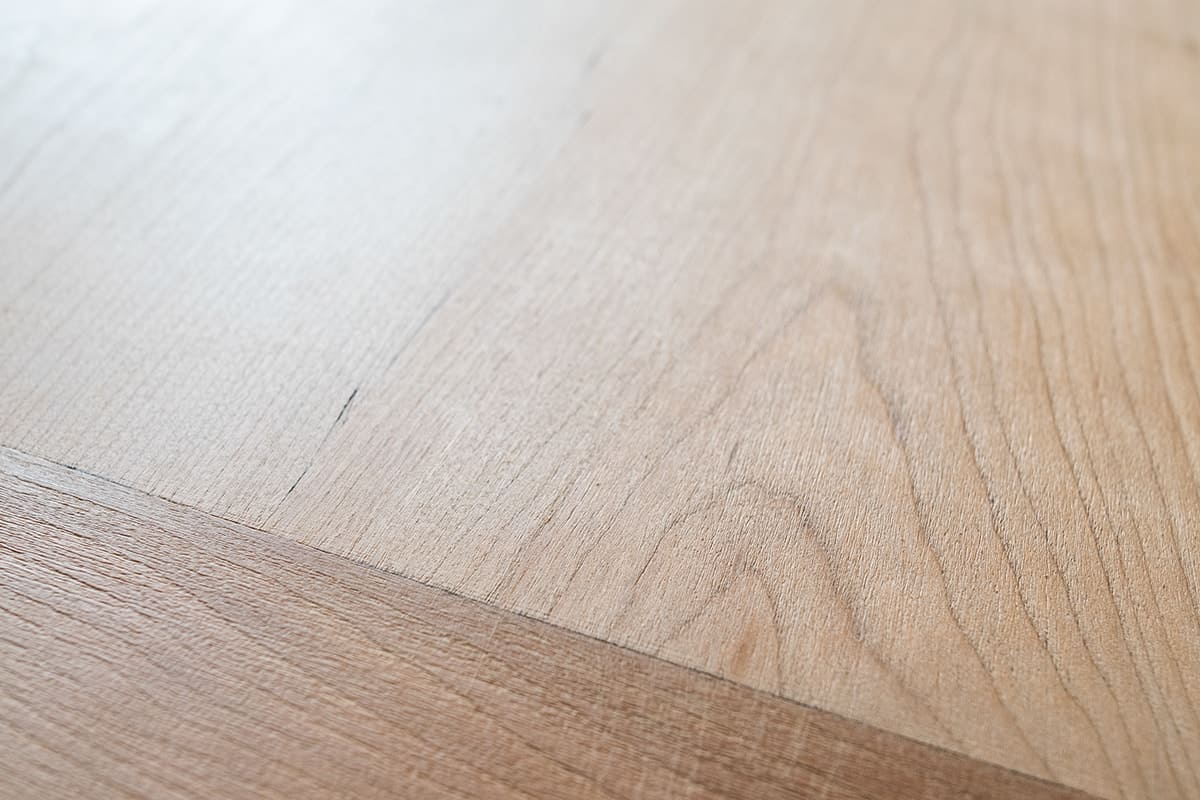
The key to a good technique is in the wire brush. Using a very stiff wire brush like this one and working in long strokes in the same direction as the wood grain, you can see the pores open a little. You will have to put a little power behind the brush to really get into the wood grain.
Tip: If you already have very pronounced wood grain, such as oak, you can skip the wire brush step. This step is done to remove a bit of the softer areas of the grain and works best on tight grained wood. Oak that has dried out usually already has a recessed grain.
Step 3: Apply a Finish
This step layers the color that contrasts with the white cerusing and what to do is up to you. You can use any color of stain, paint, or use a clear coat. This step also will help the grain expand for your cerusing layer.
Some Ideas:
- Paint it black and use white paint to ceruse which is called Ebony Cerusing.
- Stain the wood.
- Paint any color of your preference.
- Leave the wood raw. Wipe the wood with a damp cloth to raise the grain.
- Ceruse in a slightly lighter shade – It doesn’t have to be white.
What we did for this table:
I used a water based light colored stain for this. Because I am using a white paint for the cerusing, it will lighten the overall look of the stain a little bit after applied so keep that in mind when choosing the stain and color. I then put a thin layer of water-based polyurethane. The extra layer of poly was to ensure that the stain did not bleed into the cerusing paint.
Tip: I recommend adding a water-based poly layer between the contrasting if you use white paint for the cerused pattern. The reason is to keep anything from bleeding into the white. Keep the contrasting and poly layer thin so it doesn’t fill in the grain.
Step 4: The Cerusing Technique
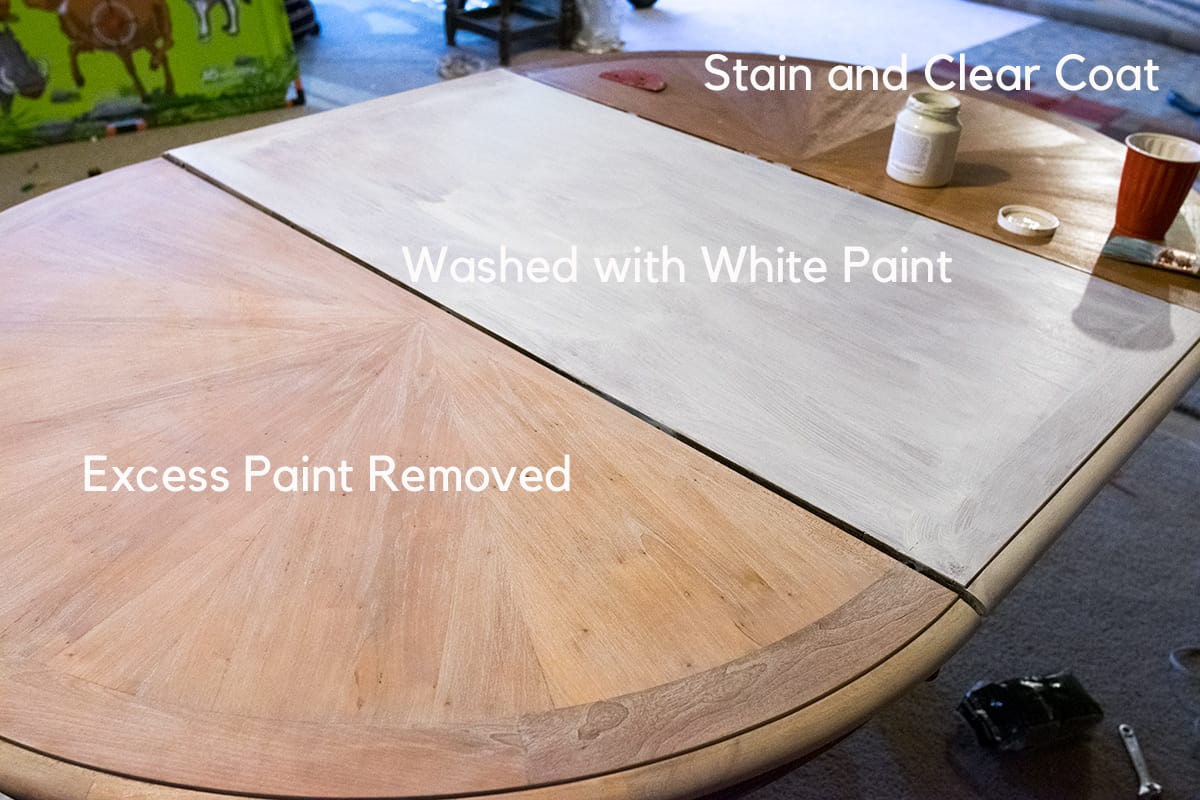
For this table, I used Fusion Mineral Champlain for cerusing (you can buy it here). I thinned it out with water, about 25%. You can use other furniture paints such as chalk paint.
Quickly brush the paint on over a whole section. To keep it even, you really want to do a whole section at a time or if you don’t have leaves like this one, do the whole top.
Give about 10 minutes for the paint to turn tacky or dry a little. The best way to remove the excess paint is with 000 steel wool, rubbing in the direction of the grain but not digging into the crevices. If the paint isn’t coming off, try using 220 grit sandpaper on a random sander can also be used. Just be sure to be careful and quickly go over the table with no pressure until the grain shows through.
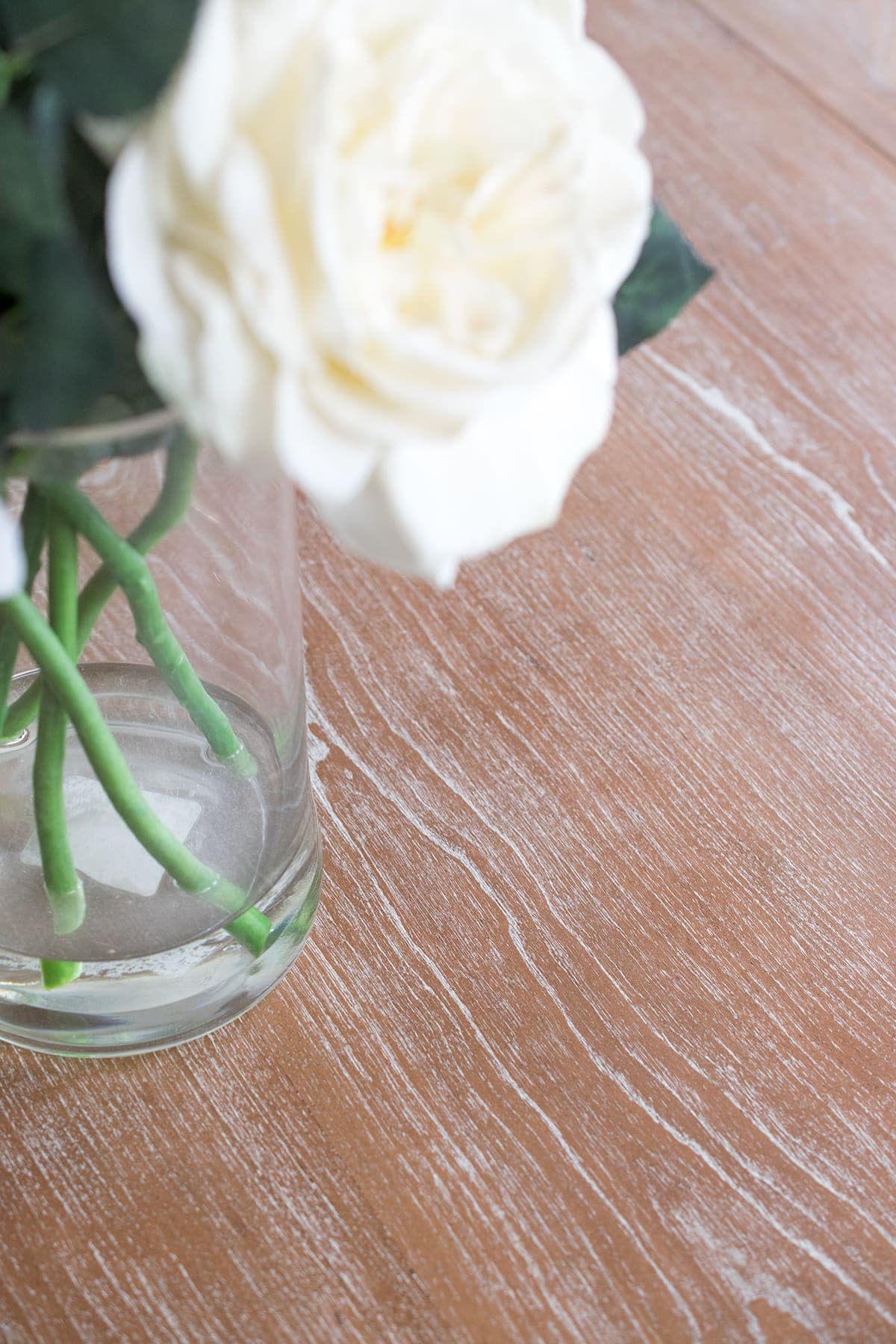
Step 6: Sealing
I finished it up by spraying my favorite water-based coating to make it ultra-durable. You can read about our favorite durable polyurethanes for furniture here to choose the right one for you.
For this table, I painted the base in Fusion Mineral Champlain and 2 coats of the same poly in satin sheen.
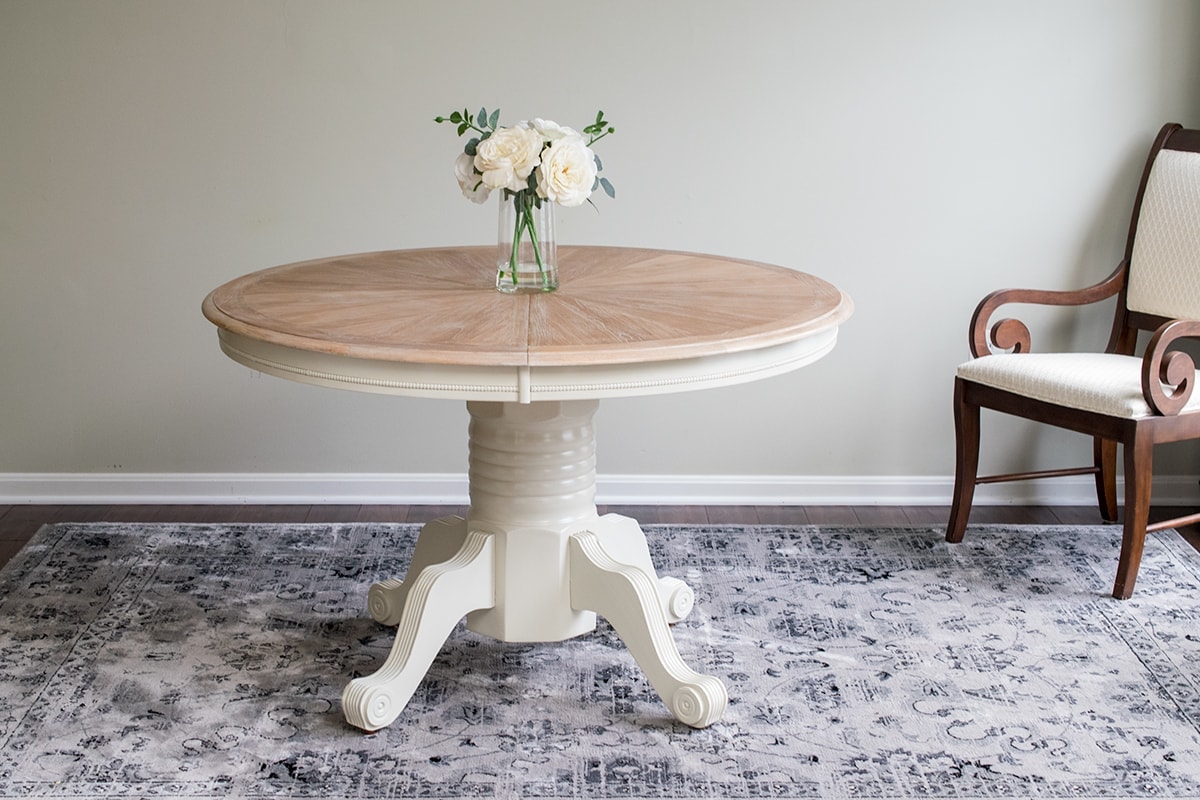
Tips for Getting the Best Result
- Always work in the direction of the grain. This includes painting, wire brushing, and removing the paint. Working across the grain will produce scratches rather than defining the grain.
- Keep your coats thin. You don’t want the layers, except for the white, to fill in the grain.
- Allow a few days to dry before adding the final topcoat. This is to allow any outgassing to happen and the paint layers to harden.
- Some woods have a chemical reaction with steel. Therefore, avoid using a steel brush. Fragments left can blacken the wood and disfigure the finish. Steel wool shouldn’t have an effect if the table is sealed prior to cerusing.
- Don’t take shortcuts on the prep work. Prepping the surface correctly is the foundation for a great result. If you remove the previous finish, always give a final sanding to even out the color and completely allow the surface to dry.
Want to see more furniture transformations? Check these out!
- How to Protect Painted Furniture
- How to Eliminate Brush Marks or Strokes
- How to Paint a Bathroom Vanity
- How to Paint Old Kitchen Cabinets
- How to Paint a Stair Rail that Lasts
- Executive Desk Makeover
FAQs
No. Wax must always be the last layer. If repainting, all traces of wax must be removed, or the paint will not bond properly.
I recommend the cerusing technique that utilizes paint rather than cerusing wax for high traffic pieces or surfaces that may be exposed to water.

Pictures don’t even do this table justice. The wood is gorgeous! So tell me what you think. Is this a technique you would try?
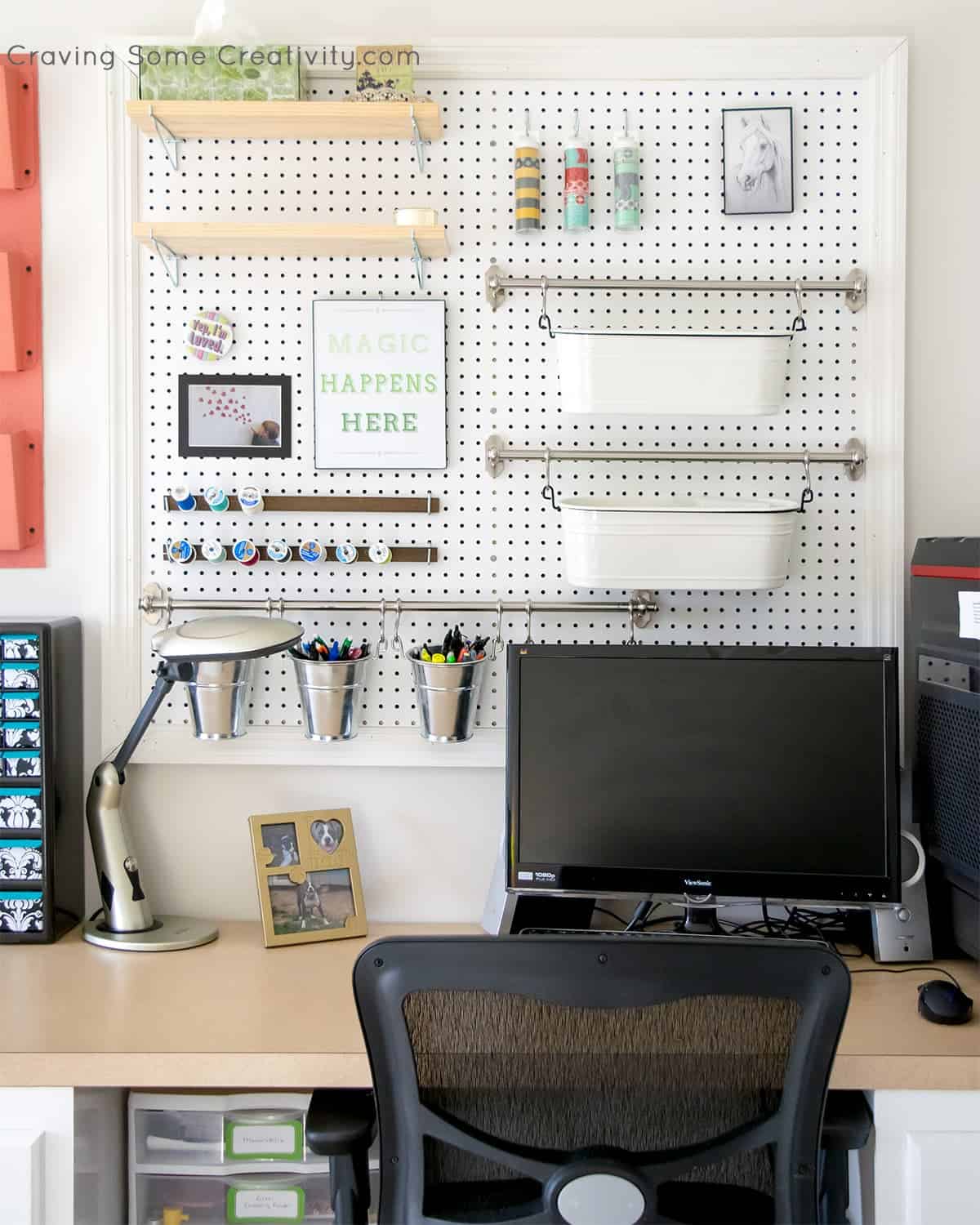
Grab our free series "Weekend Home Projects that will Transform Your Life" Sign up below to receive updates including free printables, organization tips, home improvement projects, recipes and more! |
More Furniture Makeover Projects
PS I love seeing your creations! Be sure to take a photo and tag #cravingcreative on Instagram! You can also stay in touch with me through following me on Instagram, Pinterest, and subscribing to the newsletter!
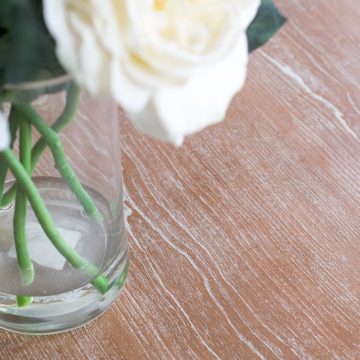
How To Ceruse Wood (aka Limed Finish)
Tools
- Paint Brush
Supplies
- Sand paper 220 and 120 grit
- Paint or Stain of your preference
- Steel Wool
- Protective Top Coat
- White Paint
- Lint free dust cloths
Instructions
- All previous finishes must be removed.
- Using a very stiff wire brush to scrape out the softer areas of the wood grain. Work in long strokes in the same direction as the wood grain. You will have to put a little power behind the brush to really get into the wood grain.
- Apply 1-2 coats of water based stain or paint of your choice as the basecoat. Use thin coats. This will raise the grain a bit more.
- If using a white paint for the cerusing, add a thin layer of water-based polyurethane with a brush. The extra layer of poly will ensure that the stain does not bleed into the cerusing paint.
- Cerusing layer technique. Thin the paint with 25% water and brush over the surface in full sections. Give about 10 minutes for the paint to turn tacky or dry a little. The best way to remove the excess paint is with steel wool, rubbing in the direction of the grain but not digging into the crevices. If the paint isn't coming off, 220 grit sandpaper on a random sander can also be used. Just be sure to be careful and quickly go over the table with no pressure until the grain shows through.
- Add a sealing topcoat. Give the surface a few days at least to dry and harden before sealing. This will make the surface more durable.
Notes
- Always work in the direction of the grain. This includes painting, wire brushing, and removing the paint. Working across the grain will produce scratches rather than defining the grain.
- Keep your coats thin. You don’t want the layers, except for the white, to fill in the grain.
- Some woods have a chemical reaction with steel. Therefore, avoid using a steel brush. Fragments left can blacken the wood and disfigure the finish. Steel wool shouldn’t have an effect if the table is sealed prior to cerusing.
- Don’t take shortcuts on the prep work. Prepping the surface correctly is the foundation for a great result. If you remove the previous finish, always give a final sanding to even out the color and completely allow the surface to dry.


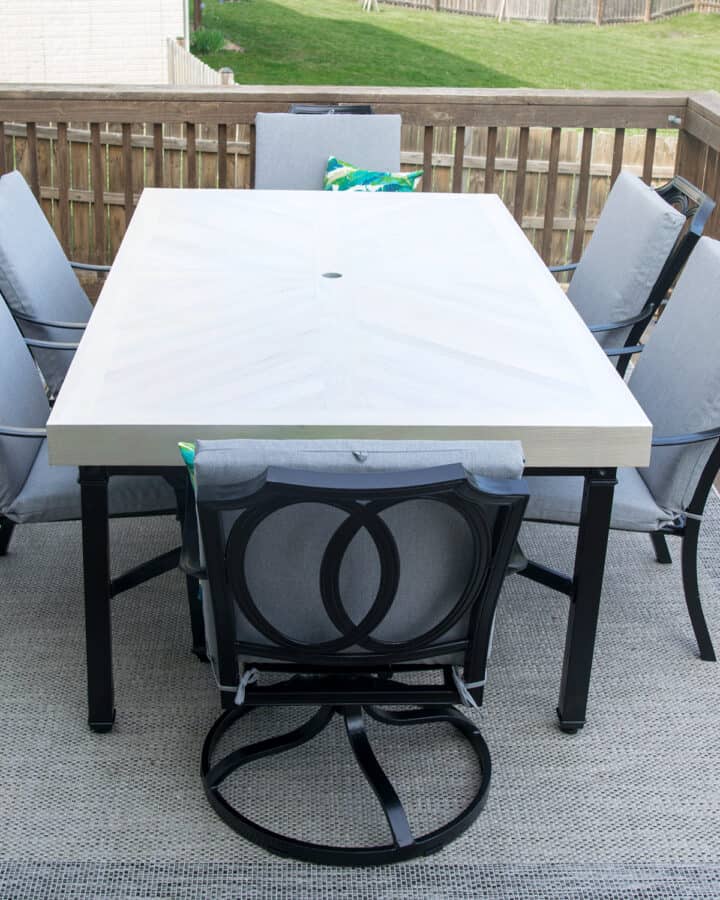
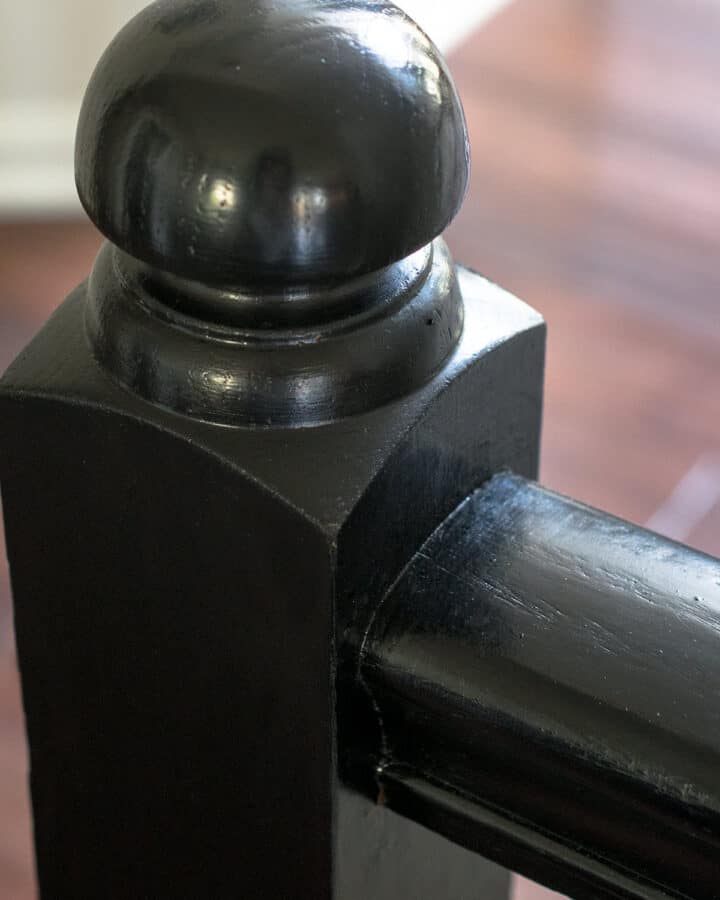
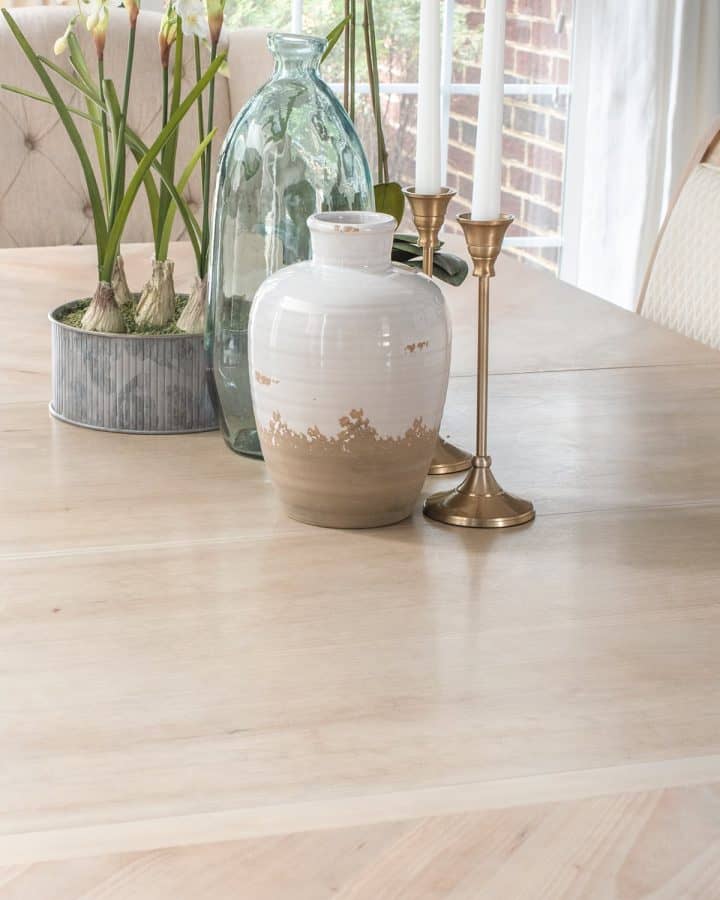
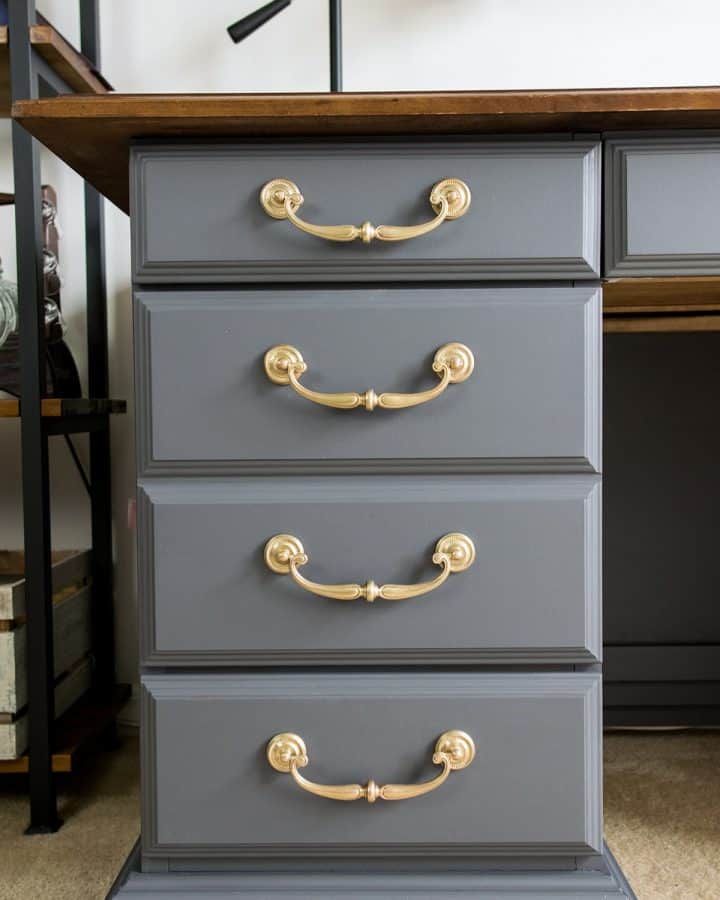
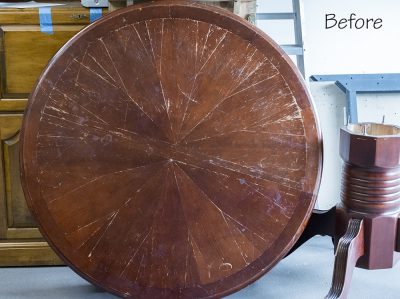
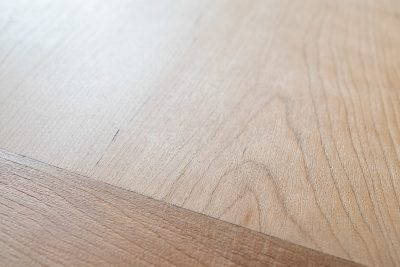
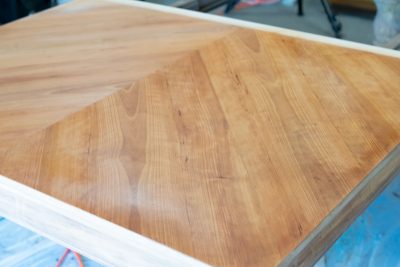
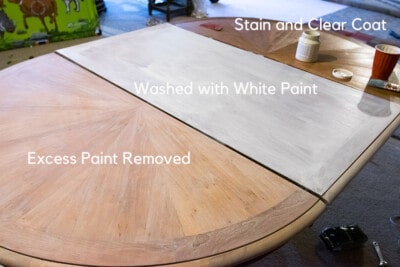
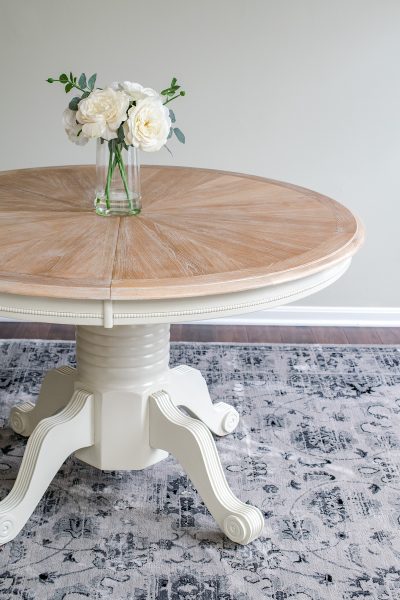
Jen says
Did you sand/knock back the raised grain after staining but before the poly and ceruse? Or wait until after the ceruse to do any further smoothing?
Rachel says
I did all smoothing after the paint layer.
Melissa says
Love the style you created with this technique! I am trying to get the courage to recreate this look with a fancy Ethan Allen table that I inherited. Question regarding the kind of paint used for the ceruse – does it HAVE to be a mineral based paint? Could you use a chalk paint or even your traditional home depot latex based paint (eg valspar, Benjamin moore, etc.). I would greatly appreciate your input! Thanks so much!
Rachel says
You can use any furniture appropriate paint that you like. I actually just updated this post with better clarity and directions, so I am glad you asked that question!
Amy says
Hi- I am trying this technique on my kitchen table. I stripped and sanded off the sealant but my table had some bumps so now I have some spots that are lighter than the rest- is it best to stain the table first so it’s all the same color? I am afraid the lighter circle patches will show up. Will they?
Rachel says
It’s hard to tell exactly what’s going on without photos. Feel free to email me Rachel at cravingsomecreativity.com if you would like more specific advice. If you have pulled off the previous stain and poly, the wood should all be the same color so I am not sure where the patches are coming from exactly. My tutorial on how to strip furniture may be of some help. Raw wood will mostly uniformly take on stain. However, you can try to stain to match the old color. I would test on an inconspicuous place or scrap wood of the same species. Matching previous stain can be done but it may take a few tries to get the exact color. Often, I find I have to mix 2-3 different stains for an exact match.
Gabi says
What did you do for the actual table base? I love the white/glossy base
Rachel says
I used the same paint as the white in the cerused surface and then covered it in several layers of the Stays Clear. Since it is a table base, I used thicker coatings than I normally do (not super heavy, but I generally use very light coats with a sprayer) to both get in the crevices well and to provide maximum protection from dings and scuffs.
Martha says
What color of pain did you use for the bottom??? Color name and brand please
Rachel says
For this table, I used Fusion Mineral Champlain (you can buy it here).
Mike says
Same question a Kristk… is the following order correct?
* Strip, Sand (220), wire brush, stain (light), poly (seal stain), paint (cerusing), sand off extra paint, poly?
Rachel says
Yes, that would be the correct order. You can choose to either sand the top off completely or strip it and then you won’t have to sand nearly as much. The main reason I sanded this table so much was to remove the deep scratches and because the finish was very far gone. I have done other tables where stripping was easier because the finish was very hard/durable. I have a tutorial on stripping furniture here. Also, staining is not a necessity. I was going for a specific color in this instance and wanted to deepen the natural wood tone so that it stood out more with the white. The sealing between the stain and the paint is to make absolutely sure that the stain will never bleed into the paint. White is the worst culprit for that.
Kristy says
Hi there! Your post was my inspiration for doing a dining table makeover, your table is stunning! Although the process nearly brought me to tears sometimes (this was my first time doing such a large project), it really helped me to read your post! I do have a question tho. I applied a few coats of poly and unfortunately I do have brush strokes. I’ve sanded down to try and get rid of them and they’re almost gone, but now I’m worried it’s not fully protected? I don’t want to have a shiny surface, but I do want it protected. What do you think is the best way to protect the top but also not have the shiny look? Would you recommend I buy a sprayer? Or can I do this with wax? Any help is appreciated. Thank you!
Rachel says
Normally, I do a few coats of poly either sprayed or brushed. If you are using a very fine grit like 220 or higher, it’s unlikely to go through all the coats if you just want to smooth out the top and take off the sheen. I might use a 320 as a last buff. Interestingly, those who want a high gloss finish actually use 1000 grit or higher sandpaper to get that slick ultra gloss look, and it still protects. Poly is waterproof, and thus a good way to know if your table is well protected is if you put a damp cloth on it, the wood will change color if it is not protected. If it doesn’t change color, then you can put more water on top just to be sure. If the wood is stained, it may change less. Hope that is helpful!
Bernadette says
Beautiful technique and finished product. Question: what is the color paint for the base of the table, and did you put a topcoat on this?
Rachel says
The table base is Fusion Mineral Champlain. Because it is a table, and a high traffic piece, I did use Benjamin Moore Stays Clear as a top coat on it.
Gabi says
What type of Benjamin Moore Stays Clear did you use? Flat, High Gloss, or Low Lustre?
Rachel says
The table and base is low lustre. I like this sheen because you can control it fairly well and change the sheen a bit. Thinner coats with a sprayer will produce a more eggshell sheen and thicker coats while it is still wet will give a strong satin sheen. Of course, I do try to avoid runs or drips so it isn’t the layers aren’t super heavy.
Leigh says
Hi! Did you remove the stain and sand before painting the base?
Rachel says
I did a light sanding, but did not remove the stain. I used a stainblocking primer underneath the paint for the base.
Angie says
Hi! Am I crazy for wanting to try this technique on my kitchen cabinets? I’m not sure what type of wood they are but they are beautiful high-quality wood cabinets with a dark stain.
Rachel says
This would be absolutely stunning on kitchen cabinets I think. The main issue would be stripping off the dark stain. That’s the messiest and stinkiest step imhho. But wow, that would be beautiful! I am totally with you on that.
Natalie says
Also If I like the color of the wood after I sanded it. Do I need to put a wood stain on it before the polyurothane? ALso your link on the polyacrclic and the last step of the polyurethane are the same product. Is it supposed to be the same product?
Rachel says
Nope, you don’t need to actually stain it at all before the poly. The polycrylic will darken the table a bit overall, but then the white wash lightens it again. Also, good eye as there was a mistype and both steps are water-based polyurethane, sometimes called polycrylic too. I used the same product for both steps.
Kristk says
So if I got it right-
Strip, scratch the table, add white paint, poly, then add ceruse top coat and the poly?
Do you sand off the white paint besides the white that got in the cracks? That’s where I’m confused
Natalie says
What color stain did you use for the wood before you put the mineral paint on?
Rachel says
I believe I used a natural stain from minwax. It is very light and sort of like natural wood. When you put poly on, it generally darkens up a bit.